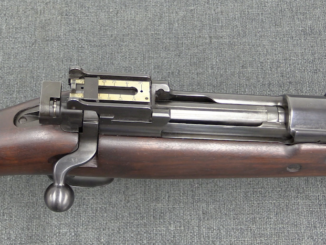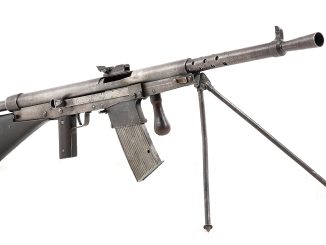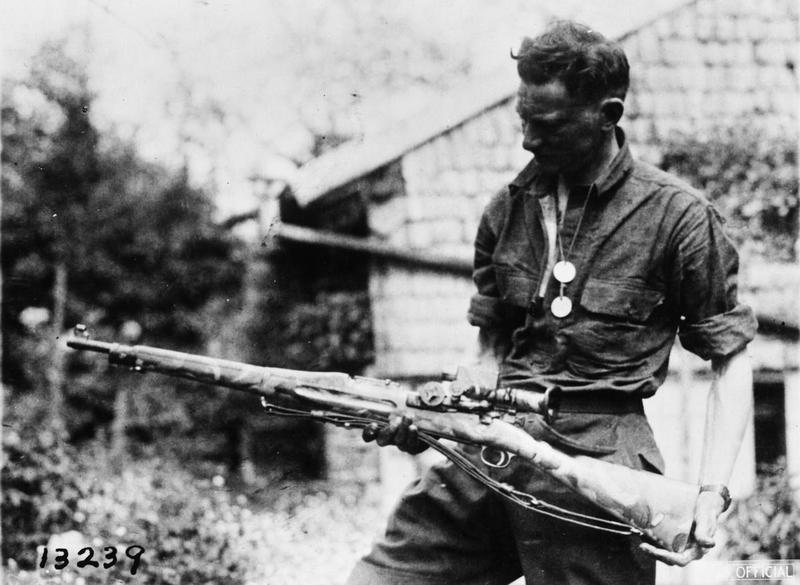One of the domestic US made pistols entered in the US military pistol trials of 1907 was this White-Merrill design. It is particularly interesting because White and Merrill submitted a manual along with the gun, which describes some of their intentions and thought processes in developing the pistol.
White and Merrill recognized that they were competing against the revolvers then in service with the US military, and specifically tried to give their semiauto pistol all the capabilities of a revolver – things like being openable with one hand, easily able to check the number of cartridges loaded, and having sights fixed to the barrel. This resulted in some unique features, like the firing-hand charging lever, which allowed the gun to carried completely safely with an empty chamber, but still easily put into action with just one hand.
Unfortunately, while it had a bunch of innovation and clever elements, the design was not competitive. In the 110-round endurance test, it suffered 40 malfunctions of various types. That, of course, resulted in it being dropped from competition. White and Merrill would go on to design a better (presumably) pistol in 1911, but it was never actually sent to the military for testing.




What an interesting pistol. A handfull of masterpiece so filled with desirable features that left very little room for reliability. First seen an example featuring “Trigger actuated locked breech” if worked in its intented manner.
Thanks Ian for revealing this all known but mysterious pistol.
A pistol full of interesting features. The relatively short breech block has the effect of raising and moving forward the center of mass. When the gun is fired this produces a torque on the slide which tends to drive it into tighter lock up. This seems similar to the Walther MPL, http://modernfirearms.net/smg/de/walther-mpl-e.html give or take an open bolt SMG and a locked breech pistol. IMHO.
The arrows on the mag follower could point to the numbers on the clear grip plate.
“filled with desirable features that left very little room for reliability”
Conclusion assembling of various promising/potentially-useful features does not guarantee feasible in result. This remind me about MORS sub-machine gun, also containing we-think-it-would-be-useful features, which in result was overcomplicated. https://www.forgottenweapons.com/submachine-guns/wz-39-mors/
Quite complicated, and probably is the reason for failure. They also had ammo problems, and I’ve heard but don’t recall where that Georg Luger brought his own ammo. The failure rate was so high, I think of Russell Turner, https://www.forgottenweapons.com/turner-light-rifle-prototype-2nd-model/. For a longish look at weapons procurement pre WWI, here is C@Rsenal on the Lewis gun. https://www.youtube.com/watch?v=FlsEmE5pM10
Norinco had a pistol a few years ago which had a similar one-handed cocking mechanism; but it was more sensible in that it used the front of the trigger guard as the lever surface rather than adding a separate (and unnecessarily complex)lever. I imagine that any soldier using the White-Merrill would snag the cocking lever on things so often that it would be far more a hindrance than a help.
The Norinco pistol’s cocking setup was copied almost directly from the Lignose/Bergmann “Einhand” of the 1920s;
http://unblinkingeye.com/Guns/Lignose/lignose.html
Based on the Chylewski patent.
I’m guessing Norinco paid no royalties to anybody.
cheers
eon
“Chylewski”
Original Chylewski automatic pistol photos can be seen here:
http://www.vestpockets.bauli.at/archiv/archiv.htm
in Schweizerische Industrie Gesellschaft (SIG) / Neuhausen section
“I’m guessing Norinco paid no royalties to anybody”
Why they have to do it? If I am not mistaken Chylewski patents are from 1910s or so, that mean expired before NORINCO automatic pistol was put into production.
“Chylewski patent”
It should be noted that this solution is feasible for automatic pistol firing .25 Auto or .32 Auto cartridge, but in bigger weapons, one-finger cycling is rather hard.
damn i wish this one had made it
The arrows on the Merrill magazine is for 123 on mag I believe thanks for the Awesome info on the firearms I love great stuff keep it up!
If they ever remake Zardoz (1974), I want whoever plays Zed the Executioner to have a re-creation of this pistol. 🙂
Probably the most “steampunk” looking self-loading pistol ever.
As for that “hook”, I suspect it’s actually a cam. As the barrel and slide begin moving backward, the underside of the barrel bumps over it, forcing the trigger nose down and ensuring that it’s out of the way.
As for why this thing was designed to be carried Condition Three (hammer down on an empty chamber), thank the U.S. Cavalry. They were still nervous about carrying a pistol with a cocked hammer and a loaded chamber (Condition One, cocked and locked) on horseback. Revolvers with the hammer down they had no problem with, although the Colt SAA was always carried hammer down on an empty chamber due to its non-rebounding hammer.
I suspect the Cavalry didn’t care much for any design that required a live round under the hammer, or two hands to load the first round from a magazine. After all, they needed at least one hand for the horse’s reins.
This thing, with a combination of empty-chamber carry and one-hand cocking, would fit their requirements and preferences exactly. And remember, at the time, the Cavalry was still considered an effective force on the battlefield.
The disillusionment of that fantasy would come seven years later, in France.
cheers
eon
“empty-chamber carry and one-hand cocking”
If it was ABSOLUTE requirement it could be done with simpler design – like Jo-Lo-Ar automatic pistol: http://9mmlargo.com/joloar/
That much is obvious if you don’t want shoot your mount in the head while drawing a bead on your intended victim.
The cocking bar of JoLoAr can’t be too long(or it would prone to break),so no trigger guard,just like all JoLoAr pistols.
Remake Zardoz? NOOOOO! I’m sure that would violate some convention on human rights. Just the sight of Sean Connery running around wearing red underpants is horrible memory. He did carry a neat Webley or Webley-Fosbery revolver though.
It was a Webley-Fosbury automatic revolver, cal..455. The theatrical blanks they used didn’t have enough recoil to operate the action, and you can see Connery grabbing the barrel with his left hand to rack the gun’s action between shots.
On the Fosbury, just cocking the (single-action) hammer doesn’t rotate the cylinder; a stud in the frame does that, tracking in slots on the outside of the cylinder like the Mauser “Zig-Zag” revolver. Hence Connery having to do it by hand.
They’d have been better off giving him a straight Webley MK VI. Double-action, nothing to do but pull the trigger.
cheers
eon
Same problem in The Maltese Falcon. It did not cycle after firing. Sigh, maybe one day Hollywood will do the Fosbery justice. Phil Schreier of the NRA museum just did a video firing Fosbery’s with one in each hand in a Brit Uniform of course. Next to Ian, those NRA museum people have all the fun. Actually, he may be the only person in history to fire two Fosberys.
“Webley-Fosbury automatic revolver”
Should be Webley-Fosbery, at least according to:
THE WEBLEY-FOSBERY
AUTOMATIC REVOLVER.
DESCRIPTION AND INSTRUCTIONS.
Interesting pistol but on a military weapon it seems dirt could easily enter that gap between the locking logs and the slide creating all sorts of problems. It would make for an odd looking holster.
I think the front trigger hook keeps the barrel in forward position when slide is not locked – the spring however is enough.
Its nice with guns that there are more than one “Holy Grail” weapon for collecting fun. Awesome to be allowed to see it. Thank you Ian, the “Indiana Jones” of gun collecting.
Interesting the use of plastic in the grip. plastic would be a very new product in 1907.
Apparently; All the parts in rest form, this is an unlocked gun with devices ready to go locked by the force of pulled trigger which connected with a lever rolling down at front and up at its rear. The movement of this lever is so arranged that, it releases striker after its forward tip completely lowering the front section of slide onto the locking recesses over the barrel, therefore, joining the barrel and slide together just before the ignition. When discharging occurs, the locked parts recoil backward for a small distance as activating the sidewardly moving disconnector mounted in the trigger lever and by means, releasing locking tip at forth and striker release tip at rear, and the plunger forcing trigger lever up, pushes the locked slide out of connection with barrel as freeing it for usual extracting, ejecting and reloading process… If everything worked in intended formation. IMHO.
Is the hammer self cocking?
If it is, how does it do it?
According to the video, the hammer cocks as striking an objection in the receiver during its backward travel with the barrel extention where it is located. It works in the same manner with the single action Savage 1907.
My search in internet gave no result for a published patent for this pistol. It would be very usefull for better understanding its parts functioning but it seems the Patent application of Mr Joseph C. White and Samuel Merill did not go further to reach to publisment stage.
Thanks 🙂
US954904 Patent for “White-Merrill C.”